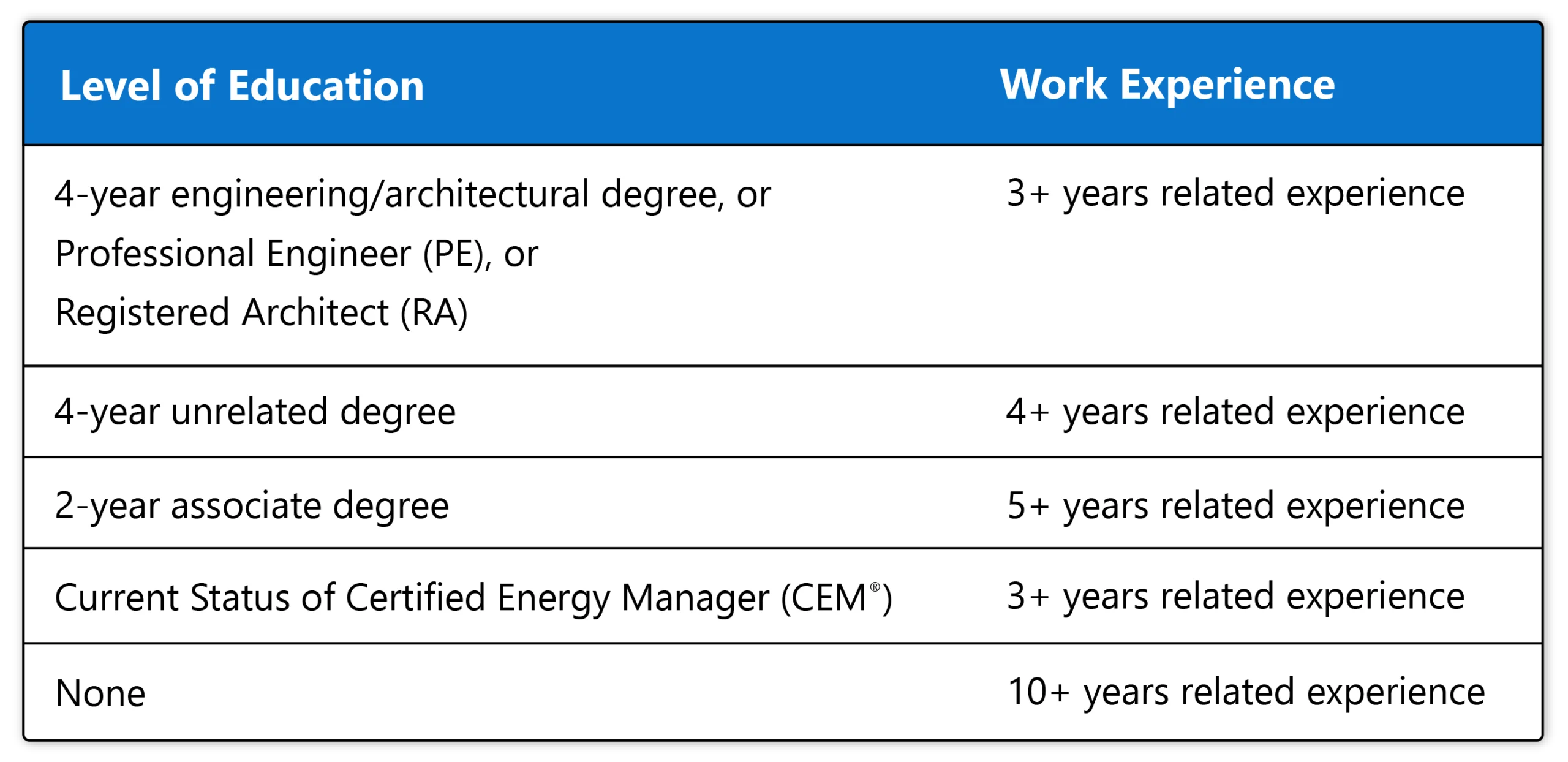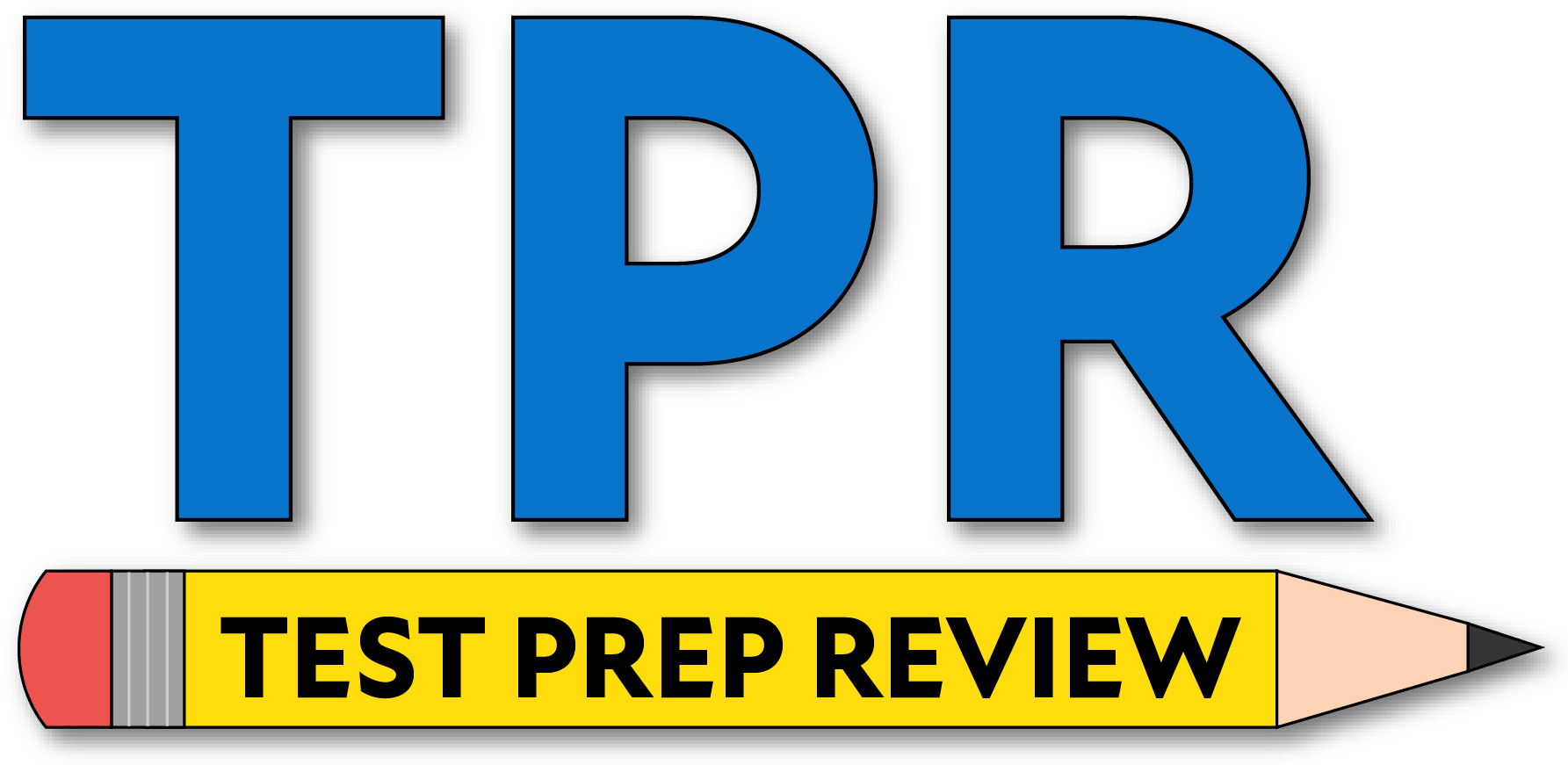If you need help studying for the Certified Energy Auditor (CEA) exam or just want some more information about what the test is like, you’ve come to the right place.
Click below to take a free Certified Energy Auditor practice test!
Exam Eligibility
Before you can register to take the Certified Energy Auditor exam, you’ll have to meet at least ONE of the combined education and work experience requirements below:

If you meet one of these requirements, you’re set to begin the registration process!
What’s on the Exam?
First, let’s talk about the questions on the exam. There are 120 multiple-choice questions total, but only 100 of the questions will count toward your score. Why is that?
The 20 unscored questions on the exam are called “trial” questions. These are added to the exam to determine if they’re good enough questions to add to future versions of the test.
The trick is that you won’t have any way of knowing which questions are scored and which ones are trial questions. They will appear just like the scored questions throughout the test.
The time limit for the exam is 4 hours. There aren’t any scheduled breaks, but you’re free to take restroom breaks as needed.
Let’s take a closer look at the different sections of the exam.
1. Developing an Energy Audit Strategy and Plan
9%-13% of the exam
- Understanding relevant codes, legalities, and industry-specific energy guidelines
- Supporting ISO 50001 energy management systems implementation
- Comprehending industry standards for energy management
- Planning and organizing an energy audit
- Identifying audit objectives and necessary procedures
- Assembling the project team for the energy audit
- Setting the appropriate audit level and scope
- Determining pre-audit tasks and preparation steps
- Specifying the data collection and tools needed for analysis
- Developing communication protocols for data gathering
- Engaging with operations and maintenance teams through pre-audit interviews
- Outlining the required format and content for the audit report
- Drafting the preliminary and final versions of the audit report
- Performing follow-up actions after the energy audit
2. Energy Use Analysis
7%-11% of the exam
- Reviewing energy rate classifications and their implications
- Defining required energy usage and additional key information
- Establishing a baseline for utility costs
- Creating an energy usage baseline for utilities
- Analyzing energy use patterns and graphical data
- Identifying relevant variables, conducting regression analysis, and determining performance indicators
- Breaking down and analyzing specific energy end-uses
- Using balance point temperature for energy assessments
- Facilitating benchmarking, including metrics such as EUI, ECI, load factor, and potential savings
- Analyzing fleet operations and associated energy usage
3. Data Collection and Analysis
8%-12% of the exam
- Understanding methods for energy modeling and simulations
- Collecting and defining pre-site data requirements
- Gathering and organizing on-site data effectively
- Identifying energy efficiency measures (EEMs) for evaluation
- Considering the interactive effects of implemented measures
4. Economic Analysis
7%-11% of the exam
- Reviewing financial criteria for client decision-making
- Calculating costs for O&M and capital energy efficiency measures (EEMs)
- Understanding key financial metrics like NPV, IRR, LCC, FCF, SIR, and BCR
- Analyzing projects with varying life spans
- Performing economic evaluations for transportation options
- Conducting detailed ‘what-if’ scenario analyses
- Carrying out comprehensive financial assessments
- Presenting the findings and conclusions of financial analyses
5. Lighting Systems
6%-8% of the exam
- Auditing lighting control systems for efficiency
- Evaluating opportunities for daylight harvesting
- Identifying and assessing energy efficiency measures (EEMs)
- Calculating potential energy savings
- Evaluating operation and maintenance (O&M) characteristics
- Determining the efficiency and performance of light sources
- Calculating replacement timelines based on lamp lumen depreciation
- Analyzing lamp and fixture types for suitability
- Recommending lamp types and characteristics for replacements
- Measuring lighting power density for compliance
- Assessing and optimizing illumination levels
6. Heating, Ventilation & Air Conditioning Systems
12%-18% of the exam
- Auditing and categorizing HVAC system types
- Evaluating HVAC terminal units for performance
- Assessing existing HVAC system efficiencies
- Identifying and analyzing HVAC system components
- Reviewing existing control strategies, including thermostat placement and scheduling
- Auditing and identifying types of chillers
- Determining piping arrangements for chilled water or refrigerant systems
- Examining filter performance and maintenance practices
- Auditing and assessing heat pumps, chillers, and split system units
- Calculating potential energy savings
- Identifying energy efficiency measures (EEMs) for HVAC systems
- Evaluating operation and maintenance (O&M) opportunities for improvement
Heating Systems
- Auditing and identifying types of boilers
- Assessing and categorizing furnace types
- Determining efficiencies of existing boilers
- Evaluating distribution systems for insulation, pressure drops, leaks, and steam traps
- Identifying and analyzing terminal units
- Calculating potential energy savings
- Identifying energy efficiency measures (EEMs) for heating systems
- Evaluating operation and maintenance (O&M) opportunities for boilers and furnaces
Ventilation Systems
- Auditing and categorizing types of ventilation systems
- Determining ventilation system requirements
- Examining filter types, classifications, and energy impacts
- Evaluating control options for ventilation systems
- Identifying energy efficiency measures (EEMs) for ventilation
- Calculating potential energy savings from ventilation improvements
- Evaluating operation and maintenance (O&M) opportunities for ventilation systems
7. Domestic Hot Water Systems
5%-7% of the exam
- Auditing and categorizing types of hot water systems
- Calculating efficiencies for hot water systems
- Identifying and adjusting temperature set points
- Evaluating circulating systems for performance
- Identifying energy efficiency measures (EEMs) for hot water systems
- Evaluating operation and maintenance (O&M) opportunities for hot water systems
- Calculating potential energy savings
- Auditing water use and consumption patterns
- Evaluating irrigation and landscaping systems for efficiency
- Identifying water efficiency measures
- Evaluating operation and maintenance (O&M) opportunities for water systems
- Calculating potential water savings
8. Motors and Drives and Compressed Air Systems
8%-12% of the exam
- Understanding the fundamentals of electrical systems
- Auditing and identifying types and sizes of motors
- Evaluating and selecting appropriate motor types
- Determining the operating characteristics of motors and drives
- Calculating the efficiencies of motors and drives
- Reviewing energy-saving potential of variable frequency drives (VFDs)
- Identifying energy efficiency measures (EEMs) for motor systems
- Evaluating operation and maintenance (O&M) opportunities for motor systems
- Calculating potential energy savings for motor systems
Compressed Air Systems
- Analyzing current conditions to identify improvement opportunities
- Identifying and assessing supply sources
- Evaluating treatment and distribution systems
- Characterizing and analyzing demand patterns
- Identifying energy efficiency measures (EEMs)
- Evaluating operation and maintenance (O&M) opportunities for optimization
- Calculating potential energy savings
9. Building Envelope
6%-8% of the exam
- Determining R-values and U-values for building materials
- Evaluating the efficiency of walls, roofs, and windows
- Assessing replacement options with alternative glass types
- Auditing building envelope infiltration for energy loss
- Calculating the thermal weight of materials
- Identifying energy efficiency measures (EEMs) for building envelopes
- Evaluating operation and maintenance (O&M) opportunities for building systems
- Understanding energy estimation and modeling techniques
- Calculating potential energy savings for building improvements
10. BAS, PAS, and EMCS
6%-8% of the exam
- Understanding strategies for energy-saving controls
- Identifying control issues through EMS evaluations
- Determining existing control points and identifying additional points for specific EEMs
- Evaluating operator knowledge and system usage
- Reading and analyzing trend logs to uncover improvement opportunities
- Assessing sensor accuracy and managing questionable data effectively
- Identifying energy efficiency measures (EEMs) related to control systems
- Evaluating operation and maintenance (O&M) opportunities for control systems
- Calculating potential energy savings from control system improvements
11. Alternative Generation & Storage
4%-6% of the exam
- Understanding various alternative energy technologies
- Exploring renewable and energy storage technologies, sites, and associated costs
- Determining the technical and economic impact of integrating renewable energy and storage
- Identifying subsidies and incentives for alternative generation and energy storage
- Evaluating opportunities in energy storage, including thermal, electrical, and demand response systems
- Assessing potential for alternative generation, cogeneration, and renewable energy sources
12. Transport
3%-5% of the exam
- Understanding types and modes of transport, such as public versus private transport
- Exploring vehicle types, transport sectors, available options, and fuel costs
- Analyzing vehicle operations and their impacts on fuel consumption, training, and awareness
- Evaluating maintenance requirements and costs for vehicles using different fuels
- Planning and managing logistics, including route and fleet management for optimal benefits
- Collecting and evaluating data, benchmarking energy performance indicators for transport
- Utilizing energy estimation and modeling methods, comparing vehicle specs to real-life data
- Identifying opportunities for vehicle improvements and upgrades
- Managing information systems, vehicle monitoring tools, and driver performance
How to Register
Once you’ve ensured that you meet all of the eligibility requirements, you can start the registration process!
The first step is attending a mandatory preparatory seminar for training.
Once your training is complete, you’ll need to submit an application on the CEA website. The application will ask you for your contact information and any documentation to prove your eligibility (among other things).
When you submit the application, you’ll also need to submit the application and testing fees, which sum to $500.
Exam Scores
The test is scored using a scaled scoring method. Here’s how it works:
For every question you answer correctly, you get one point added to your raw score. At the end of the test, your final raw score will be converted to a scaled score. This scaled score will range somewhere between 0 and 1,040.
The reason your raw score is converted to a scaled score is because everyone who takes the test is given a slightly different set of questions. Since everyone has a different arrangement of questions, and because some questions are harder than others, converting your raw score to a scaled score ensures a more even playing field.
Retaking the Exam
If you didn’t get a passing score on your first try, that’s okay! You can retake the test after a 60-day waiting period.
Keep in mind that you will have to pay the full retesting fee ($250) every time you retake the test.
FAQs
How many questions are on the Certified Energy Auditor exam?
The exam contains 120 questions.
What is the time limit for the Certified Energy Auditor exam?
The exam is timed at 4 hours.
What is the passing score for the Certified Energy Auditor exam?
You’ll need to get a final scaled score of at least 700 to pass.
How much does the Certified Energy Auditor exam cost?
The application and testing fees add up to $500.



 CEA Study Guide
CEA Study Guide CEA Flashcards
CEA Flashcards